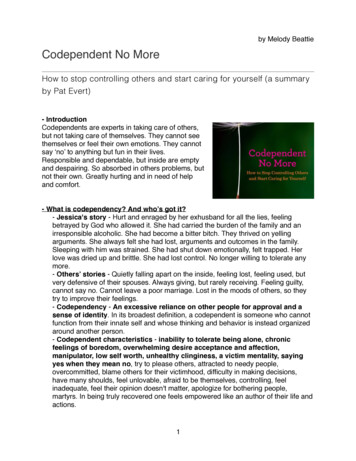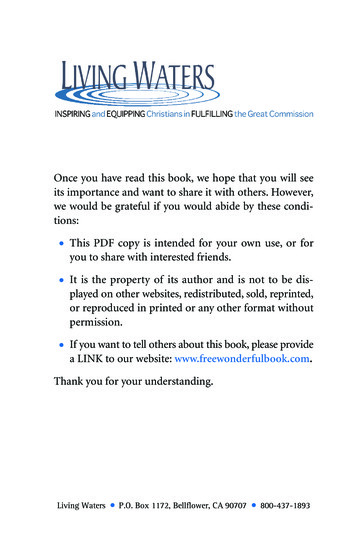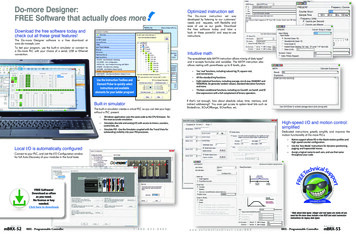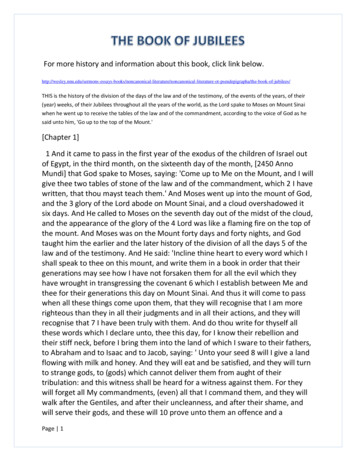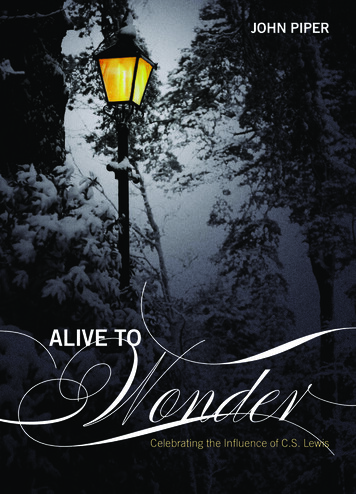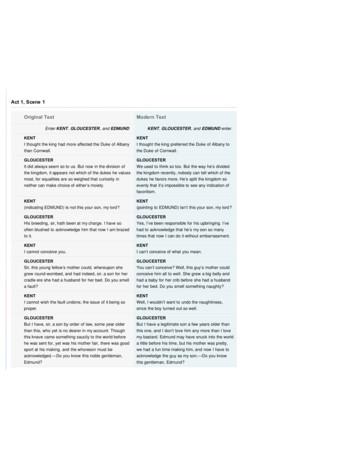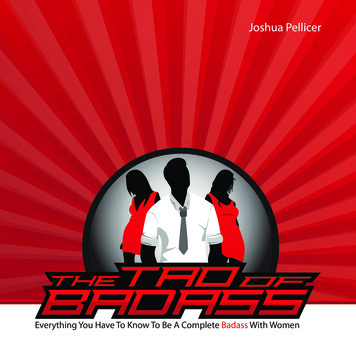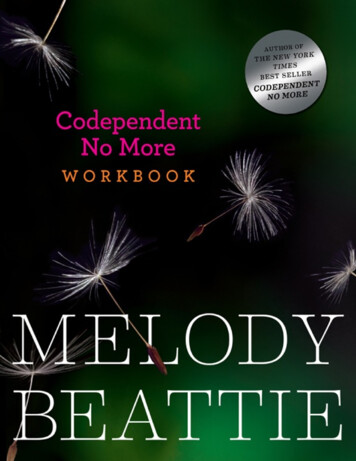
Transcription
Codependent No MoreWORKBOOK
Codependent No MoreWORKBOOKMelody Beattie
OTHER BOOKS BY MELODY BEATTIEChoicesBeyond CodependencyCodependent No MoreCodependents’ Guide to the Twelve Steps52 Weeks of Conscious ContactFinding Your Way HomeGratitudeThe Grief ClubJourney to the HeartThe Language of Letting GoThe Language of Letting Go JournalThe Lessons of LoveMore Language of Letting GoPlaying It by HeartStop Being Mean to Yourself
HazeldenCenter City, Minnesota 55012hazelden.org 2011 by Melody Beattie All rights reserved. Published 2011Printed in the United States of America No part of this publication maybe reproduced without the express written permission of the publisher.Failure to comply with these terms may expose you to legal action anddamages for copyright infringement.Library of Congress Cataloging-in-Publication Data Beattie, Melody.Codependent no more workbook / Melody Beattie.p. cm.Companion volume to Melody Beattie’s Codependent no more: how tostop controlling others and start caring for yourself.Includes bibliographical references.ISBN 978-1-59285-470-7
Ebook ISBN 978-1-61649188-81. Codependency—Problems, exercises, etc. 2. Substance abuse—Patients— Rehabilitation—Problems, exercises, etc. I. Beattie, Melody.Codependent no more. II. Title.RC569.5.C63B433 2011616.86’9—dc222010043011Author’s Note:As an independent contractor and freelance writer, I relied onprofessional research, personal experience, conclusions, and opinions toform this workbook. Although I’ve used expert opinions as resources,this book doesn’t necessarily reflect any viewpoint or opinions except myown. Neither the book nor I am affiliated with, represent, or work forany organization or treatment program. Names and certain details havebeen changed to ensure privacy and anonymity, but all stories in hereare true; none are fictionalized or composites. Even anonymous quotescame from real people.Editor’s Note:This publication is not intended as a substitute for the advice of healthcare professionals. Alcoholics Anonymous, AA, and the Big Book areregistered trademarks of Alcoholics Anonymous World Services, Inc.13 12 11 10 09 1 2 3 45 6Cover design by Nick Caruso Interior design and typesetting by MadelineBerglund
For the straightforward, delightful (anonymous) Mrs. Bee, who knew whatthis workbook needed to be and cared enough to tell me; and old-timers,newbies to codependency recovery, and everyone in between who wants tocontinually evolve because they know healing is experiential, is experimental,and “more shall be revealed.”
CONTENTSAcknowledgmentsIntroduction: Suggested Uses for This WorkbookLesson One: The Stairway to LifeLesson Two: Recognizing Your TeachersStep OneLesson Three: The BelieversStep TwoLesson Four: Surrender to DestinyStep ThreeLesson Five: You’re a KeeperStep FourStep FiveLesson Six: Ready?Step SixStep SevenLesson Seven: Creating Self-RespectStep EightStep NineLesson Eight: Keep It CleanStep TenLesson Nine: Finding and Aligning with Your PurposeStep ElevenLesson Ten: Reaching the MountaintopStep Twelve
BibliographyAppendix A: The Twelve Steps of Various OrganizationsAppendix B: ResourcesAbout the Author
ACKNOWLEDGMENTSTHANK YOU TO RENAISSANCE MALIBU AND SAL PETRUCCIFOR THEIR GREAT QUOTES AND COOPERATIONAND TO SAGE KNIGHT,WHOSE EDITING HELP LIKELY KEPT ME ALIVE.
INTRODUCTION:Suggested Uses for This WorkbookThis book will benefit those attending family group meetings for a lovedone in addiction treatment, and will be most beneficial in centers basedon the Twelve Step model. Also, people in treatment for codependencymay find this book helpful.Therapists and psychiatrists can use this book and its activities in oneon-one or group settings with clients manifesting behaviors falling intothe two main codependency categories: an extreme and oftenuncontrollable external focus on others coupled with little or no selfawareness, and confusion about their genuine, essential powers and howto use them.Although not conference approved, this workbook can be used bypeople who attend any Twelve Step group for codependents, by sponsorsworking with sponsees, and, with group conscience approval, as part ofthe Twelve Step meeting. This includes but isn’t limited to Al-Anon,CoDA (CoDependents Anonymous), ACA (Adult Children of Alcoholics),and Alateen.The content and activities address “Double Winners”—people affectedby codependency and chemical dependency. This workbook also targetspeople suffering from phobias; fear, panic, or eating disorders; andaddictions to sex or gambling. Codependency usually affects peoplesuffering from these problems too. It may be the first or second primaryproblem they address, but approaching other people’s recovery with theadage Live and let live, and not insisting that everyone plot a recoverymap identical to theirs, will be helpful to all concerned.“Lifers” attending codependency Twelve Step meetings can benefitfrom this book and the activities in it, as will people attending meetingsas needed. Twelve Step meetings may not be part of some people’srecovery protocol, but they can still benefit from the information andactivities here, and may discover this workbook helpful in their quest.People engaged in legitimate caretaking—counselors, nurses, clergy,
people caring for ill family members—who attend non-Twelve Stepsupport groups may find this workbook an asset in taking care ofthemselves.While reading through the entire workbook may be valuable initially,please follow that by returning to Lesson One, and then completing eachlesson and its activities in the order presented. Do the best work possiblebefore moving forward.The only requirement to benefiting from this book is willingness toopenly and honestly do your own work. The book’s goal is to assist youin achieving self-love and trust, living your own life, and truly lovingothers in a way that enhances you and them.Whether recovering from codependency two days or thirty years,regularly reviewing this workbook and completing the activities willcontinually reveal fresh insights about letting go, healthy detachment,self-care, and other recovery-related issues.
EDITOR’S NOTEAt the start of each lesson in this workbook, you’ll find a quote and asuggested reading from Melody Beattie’s classic book Codependent NoMore. These are your links back to pertinent ideas in that book—ideasyou can use as a reference and touchstone for working through theselessons.Before you begin, you will need to purchase a notebook or journal, orcreate a document on your computer, to use for the activities in thisworkbook.
LESSON ONE:The Stairway to Life“The Twelve Steps are a way of life.”—Codependent No MoreSuggested reading: “The Twelve Steps” in chapter 18, “Work a Twelve StepProgram”
In 2001, a friend and I traveled to China on our way to make apilgrimage around Mount Kailash in Tibet. We changed our plans,deciding to climb four holy mountains in mainland China first. We knewwe might not pass that way again.Mountain climbing in China means climbing thousands and thousandsof steps. Once, when the stairway became especially steep, I wondered ifI was surefooted enough to handle it. At that moment, a scrawny manapproached and then passed us from behind carrying about seventy-fivepounds of wooden beams on his back. The beams were to repair thetemple at the mountaintop. Energized by his devotion, I forgot my fearsand tackled the steep stairs.On the longest and hardest climb of all, I began to tire. I had onlyclimbed about halfway up the mountain, but I felt done. Then a group ofelderly women who spoke only Chinese surrounded me. Sensing myweariness, one stood in front of me, one behind, and one on each side.The women on my right and left sides each grabbed one of my hands,and we climbed together. Their energy charged through me. It wasexactly what I needed to make it to the top. There’s magic in groups thathave a single-minded purpose.And we’ll get what we need, if we’re committed to our path.When I wondered why I even wanted to climb all these steps, theanswer promptly appeared. It was a spiritual quest and a metaphor forrecovery.Your Spiritual PilgrimageIf we’re healing or recovering from codependency, we need to climb upSteps. The difference is, in recovery we don’t need to climb thousands ofsteps. We only need to climb twelve.Climbing the mountains—or tackling the problems we encounter—continually requires hard work. It can still catch me off guard when,within days of learning a lesson and breathing that trite but welcomebreath of relief, a larger, more challenging problem appears. We eitherexperience the same thing over and over until we master the lesson, orone thing after another as new lessons appear, challenging andmotivating our spiritual growth.Change happens in stages, in cycles, or by the pendulum swingingback and forth from extremes until it lands in the sacred, holy middle
ground. It surprised many people, including me, to discover that givingup codependent behaviors could take as long as it sometimes does. But ifa behavior dominates someone’s life for years or decades, change doesn’thappen overnight. This kind of transformation can take a long time andrequires hard work.This workbook, and the journal you keep along with it, will be yourlog and documentation of your spiritual pilgrimage. You’ll be takingyour lessons directly from the events that have taken place or arehappening now in your life. This workbook will provide suggestions onhow best to learn and grow from whatever happens to you while you’reon your pilgrimage. It will be targeted particularly at what we callrecovering from codependency.This workbook, the steps you climb, and the lessons will ask you tolook at your life, problems, and relationships in a way that you may notnormally do. It will ask you to use the perspective that everything thathappens is part of a Greater Plan, one created specifically for you. Ifyou’re ready to begin, sign and date your journal to honor the officialbeginning of your pilgrimage—this part of your journey. It doesn’tmatter if you’re new to recovery and this is your first day, or if you’vebeen recovering for twenty or thirty years. Every day is an opportunityfor a new beginning, the start of a new journey, and a chance to useevery single thing that occurs for your well-being and growth. You may—for memory’s sake—want to include a few notes about how you’refeeling, or about various events taking place, to honor the beginning andhelp you recall this day.Codependency Recovery: A RevolutionWhen I started working at a drug treatment center in 1975, I wanted towork with the addicts, but the program director assigned me to workwith their significant others. The center treated male addicts, so familygroup consisted of women. We didn’t have the word codependency yet.We called them significant others, but they weren’t significant to anyone,including themselves.“I don’t know what to do with them,” I told my boss, “and I’m newhere.”“Neither do we," he said. "And that’s why you get the job.”
Nobody else wanted it. The revolution hadn’t begun yet.Although Lois Wilson, Bill Wilson’s wife, began Al-Anon meetings inthe 1950s, codependency recovery began so quietly then that most of usdidn’t see it. Bill Wilson wrote the Twelve Steps and cofoundedAlcoholics Anonymous (AA). Even in the 1970s, people (I was one)thought Al-Anon was a social event for wives of alcoholics. Moretreatment centers opened. We knew that people other than old mencould be drunks and learned more about addicts. But when it came tothe needs of the family, we didn’t know what to do, and most peopledidn’t care.Numerous alcohol and drug treatment centers opened in the 1980s.People working in the field realized treatment and recovery areexperimental. Different therapies and techniques could be tried to seewhat worked.Diversion became popular, with judges sentencing people convicted ofnonviolent alcohol or drug crimes to treatment instead of prison. Thegovernment and the people felt that alcoholics and addicts deservedanother chance. Clearly, addicts and alcoholics can be instrumental inhelping each other get sober when clergy, doctors, professors,psychologists, and psychiatrists aren’t of much value. Alcoholics andaddicts listen to other recovering people, preferring shared experience,strength, hope, role models, and being genuinely understood overcollege degrees. If you can do it, I can too became a powerfultransformational belief.It would take time before these ideas finally evolved intocodependency recovery. Sometimes believing creates seeing. In othersituations, seeing creates a new belief. Blind faith may not be enough.We have to see somebody like us recover to believe we can.Significant others continued to know and stay in their place, standingquietly in the backdrop. Treatment centers went through the motions ofoffering family groups, often because of government regulations. But theresults of this therapy weren’t impressive. When I attended college to getmy degree as a chemical dependency counselor, I received the followingtraining to prepare me for dealing with the family members: "Just listen,nod your head, and agree. Say um-hum," the professor said. "Showempathy.”I did as he instructed, but it didn’t work. The training that counselorsreceived was sorely inadequate, but nothing else existed. Like the man
carrying the heavy wooden beams up the steep stairway to help rebuildthe temple, people will crawl over broken glass—gladly suffer—if theyknow it’s for a good purpose. Later, we learned codependents willsacrifice with or without a purpose. They’re happily miserable.Treatment centers didn’t see a purpose to search for the Holy Grail forsignificant others. What difference would it make? What they needed, atleast in Minnesota, was two offensive linemen and a tackle from theVikings to block the plays made by the significant others when theiraddicted boyfriend or husband began to get better. Significant othershave a finely tuned psychic radar when it comes to what’s happeningwith others, although they’re naturally unaware of themselves. When awoman senses changes in her loved one, she’ll often try to convince himto leave treatment, even though it might mean he’ll end up in jail. Shefears that if he gets well, he won’t need her. Most people withcodependency issues feel genuinely unlovable. They attach themselves topeople by caretaking, hoping to become indispensable instead.“I’d give anything to know what it feels like to be loved,” oneanonymous recovering woman said. She’d been working on herself formore than twenty years.As the 1980s rushed in, “name that pain” became the rage.Dysfunctions popped into sight as fast as we could name them. Howcould we not have seen these problems before—issues such as physical,sexual, and emotional abuse; eating disorders; and compulsive sexualbehaviors? Of all the pains named, identifying codependency and whatneeds to be done to heal from it continues to make the greatest positivecontribution to the largest number of people’s lives.When I wrote Codependent No More in 1986, I thought it might speakto a few people. Instead, hundreds of thousands of people identifiedthemselves as codependents. When awareness and identification ofcodependency popped into the culture’s consciousness, it initiallybrought excitement and relief. Identifying codependency kicked off arecovery revolution the way nothing else had since AA, Alanon, and NA.We welcomed the explosion.People enmeshed with addicts, alcoholics, or any kind of dysfunctionalfamily system finally found what they’d been looking for, even if theydidn’t know they were looking for it. They found validation. Theyweren’t crazy, they were codependent. Given the same set of
circumstances, anyone would behave similarly.Counselors had often felt frustrated with or angry at the familymembers. The rhetorical buzz questions and phrases among themconcerning codependents had become, “They’re crazier than the addictor alcoholic,” and “Who wouldn’t drink with a spouse like that?”We didn’t get the answers to the questions we’d been asking, but whenwe asked different questions, we got the answers. “Who wouldn’t actthat crazy after living with an addict or alcoholic?” And, “The addictsand alcoholics medicate pain by drinking and using drugs while thecodependents double over with pain, with no medication other than anoccasional moment of relief brought on by good old-fashioned denial.”We saw that rarely did a person have an addiction or anothercompulsive disorder without having codependency. People aren’t justchemically dependent. Most are Double Winners—chemically dependentand codependent too.More and more people recovering from chemical dependency foundthemselves relapsing or suicidal after about seven years of sobriety,when the repressed pain from codependent behaviors broke through.They needed two Twelve Step recovery programs to create a life thatworks.Each of us needs a break from the stark, raving pain of reality once ina while. Some codependents need it every day.When looked at in the right light, codependency made perfect sense.Doctors and experts used several terms to describe this condition:para-alcoholic, nonalcoholic, co-alcoholic. Codependency is the word thatstuck. The word made it into reference books, medical journals,dictionaries, and encyclopedias. The behaviors that accompaniedcodependency got tagged as survival behaviors—behaviors people do toadapt to crazy people and difficult situations.Survival behaviors are what people do when they don’t know whatelse to do. Survival behaviors aren’t preferable, because they begincausing harm to the person using them and to other people. Eventuallythey can become our downfall, resulting in secondary problems,addictions, or death.Some people insist that God never gives people more than they canhandle. However, the pain can be too great when an eight-year-old issexually abused, a mother discovers her daughter smoking crack, or ahusband learns his wife has been unfaithful since the day they married
and the children he thought were theirs aren’t his.Survival behaviors are what people do when they don’t have otheroptions for dealing with overwhelming situations. Sometimes survivalbehaviors are the best we can do. The problem is, these behaviorsbecome habitual. Then, when they turn on us and begin destroying ourlives, we don’t know how to stop doing them. Without help, we don’thave any options.Changing codependent behaviors became a central part of a hugeparadigm shift.Whenever I heard people say that, I’d nod my head and agree, eventhough I didn’t know what a paradigm was or what happened when itmoved. Later I learned it meant a new way of seeing ourselves and theworld.We felt like we discovered fire when codependency recovery began.That’s because we did. All those years of repressing emotions and livingin denial had numbed and deadened our spirits. Now with recovery, wecame alive. We aren’t trapped. We don’t have to stay stuck inrelationships that make us miserable. We’re free to choose.For so many years we thought other people held the key to ourhappiness. Then we found out we held the key to the prison where we’dbeen held captive. We might have started out as legitimate victims ofothers, but then we became victims of ourselves.Some people became skeptical or cynical about the problems thatbecame named in the 1980s, saying that dysfunctional and family meantthe same thing (which is often true). They called codependencyrecovery, the art of taking care of ourselves, a symptom of the “Me”generation, but that’s not what codependency recovery is. Parents whobarely survived the Great Depression or the Holocaust raised and trainedthe Baby Boomers, the first generation of recovering codependents.Surviving had become a way of life for these parents. That firstgeneration of recovering codependents, like our sometimes severelypersecuted parents, became well trained in feeling deprived andundeserving. Codependency recovery counteracts the deprived andundeserving belief systems, but we aren’t simply the “Me” generation. Ittook years of hard work to be able to say, “Me too.”People’s attitudes about identifying themselves as codependentsdramatically changed in the 1990s. Labeling themselves codependentdidn’t excite or appeal to people anymore. The further away we got from
our codependency, the less we wanted to admit that it had been ourgame. What once brought relief now carried more stigma than admittingto being an addict or alcoholic. I related to this stigma. Being needy,manipulative, or controlling became a source of embarrassment,especially as the public began associating codependency with psychotic,rabbit-boiling stalkers like the borderline personality portrayed byactress Glenn Close in the movie Fatal Attraction.Some recovering people began to manipulate the concept of self-care,turning it into a one-way street to use their emotions to manipulateothers while refusing to listen to anyone else’s feelings, or crying “abuse”when anyone confronted them. They used their growing knowledge oftherapy to justify dysfunctional behaviors, substituting narcissism andself-indulgence for self-love.Codependents and codependency got a bad reputation. Many peopleattended Twelve Step groups week after week, year after year, but didn’tchange. Some got worse. While some people stepped into freedom andconnected with true power, others clung to a victim self-image. Theydidn’t want to take responsibility for themselves. They preferred makingtheir pain someone else’s fault.Many people took recovery only partway. They stopped givingcompulsively, but didn’t learn how to give in healthy ways. They becameafraid to love, care for, and nurture people, which were all importantparts of a healthy life. Some insisted they’d be sick all their lives, insteadof allowing themselves to develop a healthy self-image. Other peopleblatantly insisted everyone had to attend meetings all their lives forcodependency, when that isn’t true. Some people may only need toattend groups for a while, some intermittently, some all their lives, andsome may not need to attend Twelve Step meetings at all. This isn’t aone-size-fits-all problem or solution.Attendance at some groups, especially the unhealthy ones, dwindledwhile other groups worked hard to stay healthy and on track. New kindsof support groups sprang up, offering support for people involved inlegitimate caretaking to help them remember to take care of themselves.They didn’t need Twelve Step meetings, but they could use someencouragement and support.By then, computers had become standard fixtures in most people’shomes. After the millennium, people easily attended support groups or
Step meetings online.But many people tired of working on themselves. They thoughtinitially it might take a few months to change. Then they discovered itcould take decades to let go of habitual patterns. Added to that was thatdealing with feelings became more dangerous than opening Pandora’sbox. In Pandora’s box, everything is gone except hope. There was nohope for an ending to emotions. As soon as we feel one, another one,two, or three more emotions appear.People became confused about codependency. Two people can do thesame behavior, but in one person the behavior is codependent, and inthe other person the behavior is a healthy choice. People wanted clearrules to determine what’s codependent and what’s not, instead of havingto trust themselves. But it’s not the external behaviors that determinecodependency. The test for what’s codependent is What’s the motivationfor what you’re doing? Are you doing something because you made aconscious choice to do it, or are you acting from guilt and obligation?Are you choosing to give or giving compulsively without thinking aboutwhat you’re doing? Are you hoping someone will like or love you if youdo something for, or give something to, her or him? Do you feel lovableand likable, and have self-esteem? Or do you have to prove those thingsto other people and yourself? How do you feel when you’re done doingthe behavior? Do you feel resentful, used, and victimized? Or do you feelcomfortable with and responsible for your choices?Many factors caused people to become disillusioned with recovery, butthe biggest reason that people don’t get what they can out of recovery isthat many codependents do not work the Twelve Steps. Most recoveringaddicts attend Twelve Step meetings and work the Steps as if their livesdepend on it, because their lives do. Often, codependents don’t apply therecovery principles to their lives to replace codependent behaviors andreactions.People can go to groups, talk recovery talk, but continue to stay stuckin their sighing, victimized codependent ways. People may know how tosound therapeutically correct. They know the right things to say. Buttheir behaviors do not match their words.Instead of learning to trust themselves, groups and people in recoverywanted rules. Some groups became as repressive and dysfunctional asthe family systems that originally helped people develop codependency,
operating by the same unhealthy rules: Don’t think, don’t feel, don’t bewho you are, don’t trust yourself. Some people stopped takingcodependency recovery seriously, calling it the popular “illness of theweek.”But codependency recovery—whether it involves an alcoholic oraddicted person or not—is more than a trend. It helps people get andkeep a life. Sometimes it saves their lives too.ActivityWrite about your experience with attending groups of any kindand attending Twelve Step groups for codependency recovery.Write about what you’ve worked on, a short history of yourrecovery, and your work with the Steps. Also include anyprogress, detailing particular behaviors or improvements you’vemade.Saving Your LifeWhat many people with codependency issues don’t understand is thattheir lives depend on them working the Steps. They deserve to heal fromtheir pain just as much as alcoholics and addicts do. If they earnestlybegin working the Steps—and in many cases only if they work the Steps—they’ll heal too.We no longer have only first-generation codependents recovering.Now we have multiple generations of people displaying codependentbehaviors. Many people show signs of classic codependency, no matterwhat generation they’re in: people-pleasing, caretaking, controlling, lackof boundaries, and believing they’re deprived and undeserving.But many people now demonstrate a mutated form of codependency.
Deprived and undeserving don’t describe them. They feel entitled toeverything, whether they work for it or not. It’s the other side of thecoin. They’d been overprotected and overindulged. I’ve repeatedly hadpeople contact me after a therapist or friend suggested they readCodependent No More. “I’m in pain, all messed up. I need to talk to youright away,” they insist.They don’t ask. They impatiently demand my attention.They may have been coddled for many years, but they can’t hideforever. One by one, reality is finding them. But they write to me,expecting me to give them a way to solve their problem and heal theirdiscomfort in less than a day.Frequently, when I get these urgent, demanding messages from peoplewho moan they can’t take the way they’re feeling one more second, I’llask: “What have you done so far today to take care of yourself? WhatSteps have you worked? Have you written in your journal, exercised,prayed, or meditated?” The e-mails cease, replaced by silence. “I’ll talkto you,” I write. “But not until you do at least three self-care behaviorsfirst.”That’s when the person quietly slips away. I don’t have a magic wand.Neither does anyone else.In the 1990s, instead of calling themselves codependent, many peopleavoided the word and talked about their behaviors as if they wereindividual, disconnected problems. “I have anxiety and depression.” “I’man agoraphobic, and I feel depressed.” “I have panic attacks.” “I’m full offear.” The use of antidepressants and antianxiety medications becamepopular. Some people certainly do need medications for mental healthissues, but I do ask people to consider how they might be able to takebetter care of themselves if they became sincerely involved in a TwelveStep program. If you have been taking medication, it is critical to notstop taking it unless it’s under a doctor’s guidance and care. If you havequestions about whether your medication should be continued, talk toyour doctor and work closely with him or her in making a decision.I’ve been saying this for more than thirty years to people, becausesomeone cared enough to teach me: Being happy means surrendering toand feeling all our feelings, not just feeling happy. It means being at peacewith whatever is and how we feel—angry, upset, sad—each moment intime.Working the Steps usually leads to doing other recovery work, such as
family-of-origin work, going to therapy, or focusing on changing aparticular behavior, but the force that moves us forward in recovery,that causes us to go against gravity by going up, not down, has been, is,and likely will continue to be, for most people, working the Steps.Learning these principles and applying them can even benefit peoplewho don’t attend Twelve Step groups.Alcoholism is described as cunning, baffling, and powerful. But thosewords describe codependency too. Codependency can be absolutely andtotally exhausting. It drains and depletes people, puts a blindfold onthem, spins them around in circles until they’re dizzy. Then people try togo on with their lives and wonder why they can’t.You’re not crazy. Codependency can make you feel crazy, though.When you look at yourself with eyes of love instead of criticism, you’llsee that everything happens for a reason, including what you do. Yourcodependent behaviors make perfect sense. Your goal was to survive.You did. Now, by working the Steps, first by going through t
Codependent no more. II. Title. RC569.5.C63B433 2011 616.86’9—dc22 2010043011 Author’s Note: As an independent contractor and freelance writer, I relied on professional research, personal experience, conclusions, and opinions to form this w
